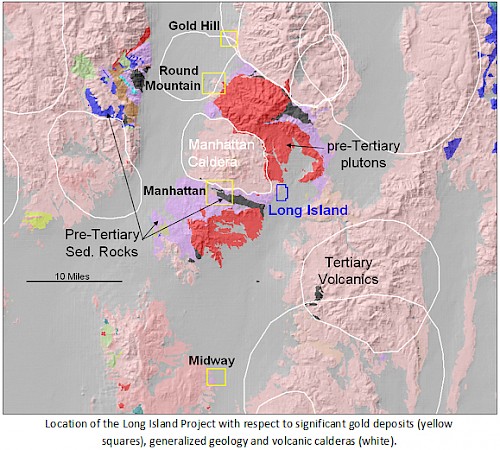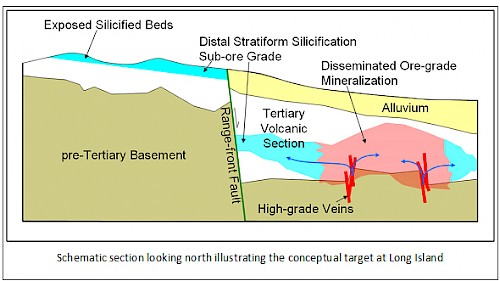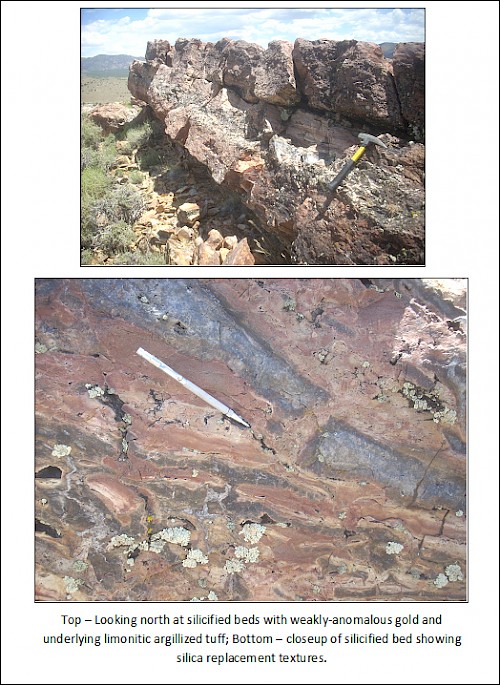System type: Volcanic-hosted, Low-sulfidation Epithermal Au-Ag
Target: Stockwork vein and disseminated gold
The Long Island Project lies along the eastern edge of the Toquima Range in Nye County, Nevada, 12 miles southeast of the world-class Round Mountain gold deposit and 6.5 miles east of the Manhattan gold district. The project contains extensive, stratiform, chalcedonic silicification within Tertiary tuffaceous volcanic rocks which dip gently eastward into the range front and likely extend eastward under post-mineralization alluvium in Ralston Valley.
Multiple silicified beds up to about 8 feet thick form a 150-foot thick section of silicification with intervening weakly argillized volcaniclastic and ash-flow tuff beds. Unoxidized zones are locally present within the silicification and contain fine-grained disseminated pyrite. The silicification is locally anomalous in gold, arsenic, antimony and mercury.
The silicified beds are proximal to underlying Ordovician basement siliciclastic rocks and are also exposed within 2,500 feet of the large Cretaceous Belmont pluton, which extends northwest across the Toquima Range to the volcanic-hosted Round Mountain deposit. The silicification is considered to represent the distal stratiform portion of a hydrothermal system that may be centered under pediment cover to the east, where there has been minimal exploration. Many productive volcanic-hosted systems in the Great Basin are proximal to underlying basement, and it is possible that hydrothermal fluids that resulted in the stratiform silicification were sourced from a discordant basement-hosted structural system which then spread laterally in the basal parts of the Tertiary volcanic section. This distal setting is consistent with the weak geochemistry in the exposed silicification. In addition to the favorable range-front setting, where many gold-bearing volcanic-hosted epithermal systems occur in the Great Basin, the project also lies at the corner of a large pre-Tertiary pluton. This pluton-proximal setting is also an important characteristic of productive Tertiary gold systems in Nevada – both sediment- and volcanic-hosted. Hydrothermal plumbing is enhanced and focused around the deeply-rooted margins of large plutons. The ~15Moz Round Mountain gold deposit lies at the edge of the same pluton on the opposite western flank of the Toquima Range. The target deposit concept is a volcanic-hosted disseminated gold system concealed by valley-fill alluvium with potential for high-grade veins along the basement contact and within the basement (e.g., the nearby Midway gold deposit).
Eight modern drill holes are known in the project area; however, most of these holes were within the range-front zone or on bedrock, with only one hole significantly outboard into the pediment northeast of the exposed silicification. Little information is known about this drilling.
The next phase of exploration should begin with a geophysical program aimed at constraining the depth of alluvial cover and identifying buried faults outboard of the exposed silicification. Gravity and controlled-source audiomagnetotellurics (CSAMT) would be two appropriate methods. The geophysical program would be followed by an initial drilling program.



